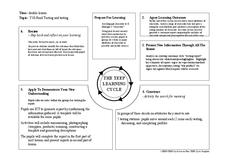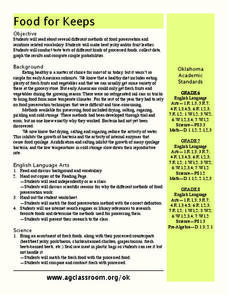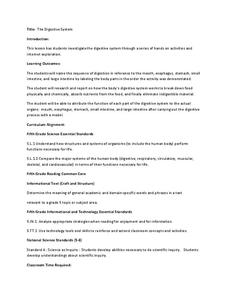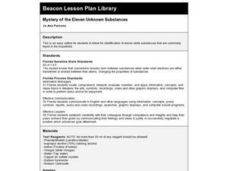Curated OER
Food Testing and Tasting
Students list the attributes of chocolate as an unprocessed and processed substance. They conduct a taste test of various chocolate bars and give a
rating for each attribute they previously listed. Students create a consumer review...
Curated OER
Food For Keeps
Students explore food. In this processed and fresh foods instructional activity, students discover how some foods are processed and how they differ from fresh food. The complete group activities and an individual reading assignment. This...
Curated OER
The Digestive System
Discover how the human body's digestive system works with a brain and stomach friendly activity. Scholars taste test a variety of foods to find out how they behave once in the mouth. Class members then play a game called Move That...
US Apple Association
Apples: A Class Act! (Grades Pre-K–3)
Discover the nutritional wonders of apples and get to know Johnny Appleseed with a plethora of learning experiences that cover subjects math, history, English language arts, health, and arts and crafts. Activities include an apple...
Curated OER
Flavors Of The World
Young scholars engage in a simulation/role play. They analyze information about flavors and ingredients that create a unique flavor of a culture. They make recommendations to the executive chef on menu items appropriate for international...
Curated OER
Taste
Students collect data to be used in selecting the class favorite taste. They predict which among the common flavors such as salty, sweet, sour, or bitter is preferred.
Curated OER
International Festival: Germany
Students complete several activities to learn about the German culture. In this German culture lesson, students read the 'Hansel and Gretel' story and create a paper gingerbread house. Students complete a matching game for the story....
Curated OER
BUILD A BURGER
Students recognize and name the products used to build a hamburger. They review the USDA Food Guide Pyramid. Students are given worksheets, and they match the burger parts to the picture parts. They conduct a taste test on samples of the...
Curated OER
Holes, by Louis Sachar
Students use reading fluency, comprehension, vocabulary, written expression to write in journals as reading "Holes" by Louis Sachar. Some days are set aside for tests and/or food tasting.
Curated OER
In Touch with Apples
Students read "How To Make an Apple Pie and See the World", the story of a girl who traveled the world to find the ingredients to make her apple pie. They conduct a series of interdisciplinary activities including testing their senses,...
Curated OER
Tongue Map
Students explore human anatomy by conducting a human senses experiment. In this taste lesson, students identify the main purpose of a tongue and how it enhances our eating habits. Students utilize baking coca, lemon juice, salt and honey...
Curated OER
The Worm: Reading Comprehension
Five multiple choice questions test young readers' understanding of a poem about the earthworm. Answers provided.
Curated OER
Yummy Adjectives
Fourth graders recognize and brainstorm descriptive adjectives to use in their writing. They work in pairs to take a taste and touch test and record their adjectives used to describe the food and knick-knacks on handout. This is a great...
Curated OER
The History of Maple Syrup
Students explore the process of harvesting maple syrup. In this science and history lesson, students make their own maple syrup and create a picture book that shows the Native American and American pioneer methods of making the syrup.
Curated OER
Nutrition and the Media: Cereal Box Consumerism
How many treats do you buy each week? Learners investigate diets and how the media tricks consumers into purchasing unhealthy snacks. They will investigate the designs and logos affiliated with cereal boxes and identify specific phrases...
Curated OER
Paragraph Structure
Practice writing paragraphs with this scaffolded worksheet. The "hamburger" model is used on the second page, following some examples and guided practice on the first page. Give beginning writers concrete, tangible support as they embark...
Curated OER
Paragraph Structure
Make sure your writers have the buns and the meat in their paragraph burgers with paragraph exercises. The resource gradually leads up to individuals writing their own paragraphs, starting with identification exercises, moving on to...
Northwest Regional Educational Laboratory
Writing Prompts for Elementary, Middle and High Schools
Work on descriptive, narrative, persuasive, and expository writing with 110 prompts! The writing prompts are organized by type of writing. Several are separated into collections for younger students so you can find prompts for your...
Curated OER
Beginning Sentence Completion Exercise 38
In this online interactive grammar skills worksheet, students examine 10 sentences that are missing words and select the appropriate words to complete each of the sentences and match them to the sentences. Student answers are...
Curated OER
Reading Comprehension
In this reading comprehension learning exercise, learners read a passage and answer questions based on the main idea of the passage. Students answer 4 questions about the passage.
Curated OER
Advanced Critical Reading: Salt
In this critical reading worksheet, students read a passage regarding salt then answer three questions based on the reading.
Curated OER
Good/Bad Headlines BBC News School Report
In this BBC News good/bad headlines school report worksheet, students read 48 possible report headlines. They place a tick mark next to good headlines, and put a cross next to bad headlines.
Curated OER
Microbes and Health
Sixth graders become acquainted with the concept of how microorganisms cause disease. They role play that some class members have exhibited some alarming symptoms. Groups must determine which disease the symptoms are pointing to.
Curated OER
Mystery of the Eleven Unknown Substances
Fourth graders identify eleven white substances that are commonly found in the household. They, in pairs, perform experiments on a variety of substances, and must identify them based on the reactions they observe.























